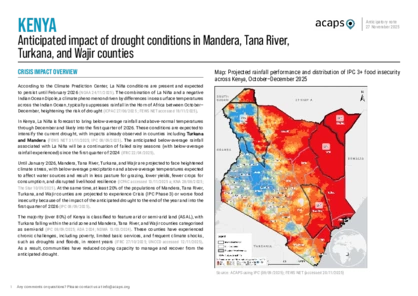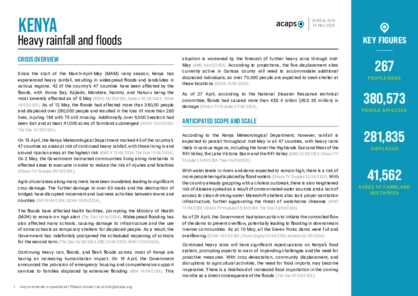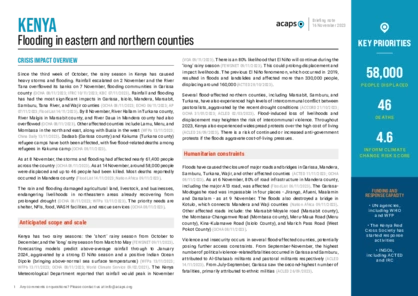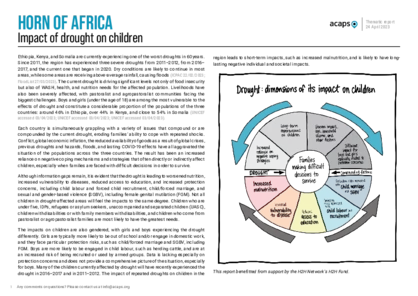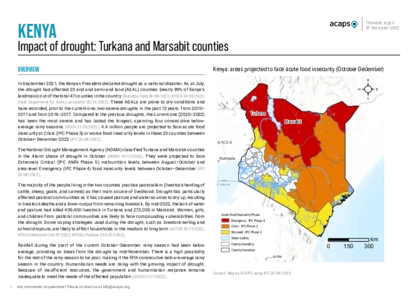Latest updates on country situation
18 November 2025
From October 2025 to January 2026, an estimated 2.1 million people across Kenya’s pastoral regions are projected to face high acute food insecurity of Crisis (IPC Phase 3) or worse levels, particularly in Garissa, Mandera, Marsabit, Tana River, Turkana, and Wajir counties. This represents a 2% compared to the same period last year. The primary drivers of the significant expansion of these widespread crisis outcomes included forecasted significantly below-average short rains from October–December and persistently high temperatures. This climactic failure will severely hinder rangeland recovery, leading to atypically low livestock productivity and reduced herd sizes. The resulting collapse in household income, coupled with elevated staple food prices, will limit purchasing power and force the unsustainable exploitation of livelihood assets. The deterioration is expected to be most acute during the short rains season, with resource-based conflicts acting as a major aggravating factor. (IPC 08/09/2025, FEWS NET 31/10/2025, WFP 11/11/2025)
14 October 2025
By September 2025, Kenya was hosting 864,693 refugees and asylum seekers, primarily in Dadaab, Kakuma, and Kalobeyei. The 2025 REACH Multi-Sector Needs Assessment indicates a sharp deterioration in living conditions from funding shortfalls, forcing WFP to reduce rations to 28% of the minimum food basket and suspend cash assistance. Food insecurity remains the most pressing need. Households increasingly rely on in-kind aid, borrowing, and credit. Water access is unreliable, and 72% of households lack handwashing facilities, heightening WASH-related health risks. Child health and nutrition outcomes have worsened; only 44% of children have received vitamin A supplements and 53% deworming treatment. The average household income – KES 6,982 (USD 54) – remains well below the minimum expenditure basket of KES 16,424 (127), pushing 74% of families to adopt potentially harmful coping strategies. Education attendance has declined amid financial barriers and child labour. Only 10% of households received aid in the past three months, reflecting growing vulnerability across camps. (IOM/REACH 06/10/2025, UNHCR accessed 16/10/2025)
15 September 2025
Since June 2025, over 9,300 South Sudanese refugees have returned from Kakuma and Kalobeyei camps in Kenya, with daily arrivals peaking at over 220 in August. The movement is prompted by food ration cuts that have left 85,000 (45% of camp populations) without assistance, triggering protests. Kakuma and Kalobeyei were hosting nearly 191,000 South Sudanese refugees. Two-thirds of the returnees are children, many arriving through Nadapal town into eastern Equatoria before moving to Budi, Ikotos, Kapoeta, and Torit towns. Families face ambush risks, lack of reception facilities, unsafe sanitation, and exposure to gender-based violence and disease at the border. While many returnees rejoin relatives, host households are increasingly overstretched, leading to overcrowding, food insecurity, and limited health and shelter access. Urgent needs include food, safe water, health services, and protection support especially for children and women, alongside assistance for host communities. (UNHCR 11/09/2025, TRT Afrika 29/08/2025, Radio Tamazuj 14/08/2025)
26 August 2025
Since late July 2025, intensified cross-border fighting in Betel Hawa town of Gedo region, Somalia, has spilled into Mandera East subcounty in Kenya, triggering large-scale displacement. By 17 August, over 7,700 people had been displaced within the township ward, while around 3,000 refugees were registered in camps at Barwaaqo, Duse, and Shafshafey schools by 19 August. The displaced population largely comprises women-headed households with young children, heightening protection concerns. Nearly half of the affected households have reported losing their livelihoods in the past month, leaving families without income and dependent on aid. Shelter conditions remain precarious, with people staying in schools, tents, and open spaces. Food shortages, limited safe water, and disrupted health services further heighten needs as the crisis places additional strain on the already limited resources. (IOM 20/08/2025, KNA 30/07/2025, FTL 31/07/2025)
06 August 2025
The deteriorating socioeconomic situation in refugee camps, especially in Turkana and Garissa, has contributed to an increase in criminal activities, tension between refugees and host communities, and demonstrations over scarce resources. Protests turned violent when police clashed with protesters in Kalobeyei settlement (28 June) and Kakuma camp (29 July), where reduced food rations have significantly increased malnutrition, particularly among children, pregnant and lactating women, and people with chronic illnesses. Gender-based violence, including intimate partner violence and early marriage, is prevalent, heightened by economic pressures, overcrowding, and entrenched social norms. Water shortages and intermittent services in the camps have prompted internal relocations. Access to protection services, adequate shelter, and education is limited, with girls at increased risk of early marriage and boys more likely to engage in informal labour. In Dadaab’s Ifo and Dagahaley camps, dengue fever outbreaks have been linked to poor waste management, higher temperatures, and limited healthcare access. (ECHO 29/07/2025, Radio Ergo 22/07/2025, [USCRI 29/07/2025] (https://reliefweb.int/report/kenya/uscri-calls-immediate-action-refugees-face-man-made-starvation-crisis-kenya))
10 June 2025
A tree locust infestation has been affecting Turkana South, Turkana county, since early 2025. The pests are destroying acacia trees, sorghum crops, and pastureland. These are critical resources for the communities in the arid and semi-arid land region. The outbreak coincides with a projected deterioration in food security between April–June resulting from below-average rainfall. (The Eastleigh Voice 04/06/2025, Govt. Turkana County 03/06/2025, IPC 21/03/2025)
13 May 2025
Since April 2025, Kenya’s arid and semi-arid land regions, including Garissa and Turkana, have faced rising WASH-related risks owing to heavy rains and flash floods. Damaged infrastructure, stagnant water, and poor sanitation have increased the outbreak risk of diseases such as cholera. Recent assessments indicate that over 80% of schools lack proper toilets. In Garissa, specifically, 59% have no water access, while in Turkana, many rely on unsafe sources. Refugee influxes strain services, leaving both host and displaced populations highly exposed to waterborne diseases. (ECHO 23/04/2025, REACH 28/04/2025, IFRC 25/04/2025)
current crises
in
Kenya
These crises have been identified through the INFORM Severity Index, a tool for measuring and comparing the severity of humanitarian crises globally.
KEN001 - Multiple crisis
Last updated 27/11/2025
Drivers
Drought/drier conditions
International Displacement
Crisis level
Country
Severity level
3.4 High
Access constraints
1.0
KEN002 - International displacement
Last updated 27/11/2025
Drivers
International Displacement
Crisis level
Country
Severity level
2.9 Medium
Access constraints
1.0
KEN003 - Drought in ASAL areas
Last updated 27/11/2025
Drivers
Drought/drier conditions
Crisis level
Country
Severity level
3.2 High
Access constraints
0.0
Analysis products
on
Kenya
27 November 2025
Kenya: Anticipated impact of drought conditions
DOCUMENT / PDF / 497 KB
This report examines projected drought conditions in a select sample of northern and eastern counties (Mandera, Tana River, Turkana, and Wajir) in ASAL regions that climate forecasts and early warning indicators project will experience some of the most severe impacts.
14 May 2024
Kenya: heavy rainfall and floods
DOCUMENT / PDF / 2 MB
Since the start of the March-April-May (MAM) rainy season, Kenya has experienced heavy rainfall, resulting in widespread floods and landslides in various regions. 42 of the country’s 47 counties have been affected by the floods, with Homa Bay, Kajiado, Mandera, Nairobi, and Nakuru being the most severely affected as of 6 May.
16 November 2023
Kenya: flooding in eastern and northern counties
DOCUMENT / PDF / 867 KB
Since the third week of October, the rainy season in Kenya has caused heavy storms and flooding, significantly impacting Garissa, Isiolo, Mandera, Marsabit, Samburu, Tana River, and Wajir counties. As at 8 November, the storms and flooding had affected nearly 61,400 people across the country.
24 April 2023
Horn of Africa: Impact of drought on children
DOCUMENT / PDF / 5 MB
Ethiopia, Kenya, and Somalia are currently experiencing one of the worst droughts in 60 years. The current drought is driving significant levels not only of food insecurity but also of WASH, health, and nutrition needs for the affected population.
07 December 2022
Kenya: impact of drought in Turkana and Marsabit counties
DOCUMENT / PDF / 2 MB
In September 2021, the Kenyan President declared drought as a national disaster. As at July, the drought had affected 23 arid and semi-arid land counties out of the total 47 counties in the country. 4.4 million people are projected to face acute food insecurity at Crisis (IPC Phase 3) or worse food insecurity levels in these 23 counties between October–December 2022.


